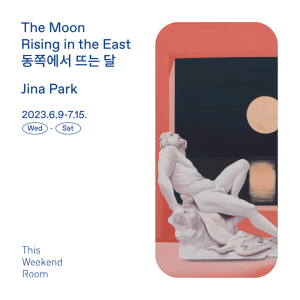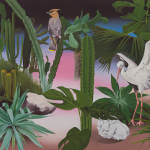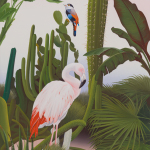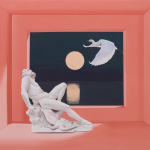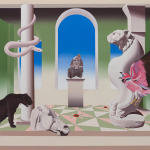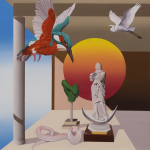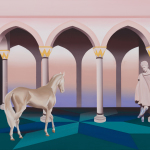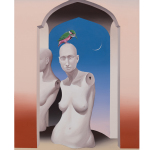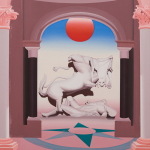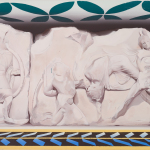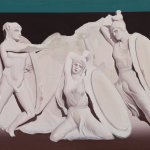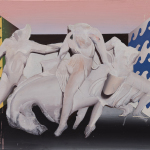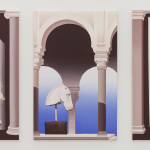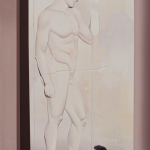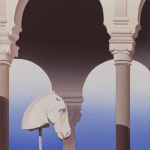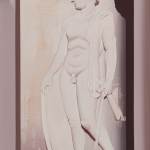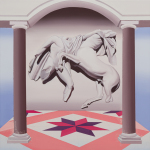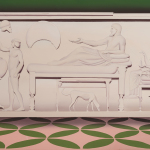The Moon Rising in the East
9. June-15. July 2023
The soft yet captivating color palette draws us closer to Jina Park’s paintings. Upon closer observation, we begin to notice motifs gleaned from ancient civilizations, classical sculptures, and botanical imagery. Classical architectural structures—such as columns, arches, corridors, and alcoves—and ornamental surfaces—such as patterned walls and floors—appear to create space; however, there is no recognizably rendered three-dimensional structure. More than that, the time of day, whether it is dawn or dusk, is unclear. Interior and exterior, day and night, civilization and nature coexist in the paintings, floating around, untethered to depth and dimension. Are we witnessing the artist’s inner landscape or an archive of images, a virtual world the artist constructed? Nevertheless, the serene and rather static compositions embody a new kind of beauty as well as a sense of tension.
The ambiguity in the seemingly meticulously organized paintings stems from the absence of common sensical conventions and educated standards. The areas with columns and arches appear to have depth but are flat. The patterns composing the floors and ceilings create illusory effects rather than suggesting a vanishing point. No motif, whether plants or animals, stands out prominently or recedes into the background. So, what kind of “space” are we beholding? The very point of deviation from our intuitive expectations leads us to reconsider the relationships among the motifs depicted in the painting, such as sculptures, animals, plants, the sun, and the moon. In this sense, the predictable dynamic between the protagonist and the supporting character in a typical narrative does not apply. Flying birds, beasts, and lush vegetation lack a sense of vitality and are treated as equals to the sculptures. Situated beyond the influence of dominant historical narratives, on the indefinite boundary of recorded and learned power, Park’s paintings pose important questions. Have we ever questioned the authority of classical images, upheld as culturally superior and aesthetically ideal, that gain power from the limited quantity of “originals,” ancient copies, or ruins? Have we ever questioned how the Western tradition of museums and galleries shapes the art scene today and how it overlooks and negates certain beings? Is it at all possible to view the world based on individual taste and perspective? What propels us? How is desire educated?
Like many other fields in society, painting has many rules and precedents. Where there was no original object to copy or rare replicas sought after by aristocrats, artists honed their skills by copying the next closest representation of the object, aiming to devise and master their own painting styles. Gimyeongjeoljido and Chaekgado, popular still-life painting styles in 18th-century Eastern art, allowed for more freedom from the patron or artist than landscapes and portraits. In Parkgodo-style folding screens, objects that the patron cherished or wished to possess were introduced into the image alongside the base motif of a bronze vessel. Whereas in Baeknabdo-style folding screens, pages of an illustration book were freely rearranged by image or theme at the artist or the patron’s will. In other words, the patron’s preferences or the painter’s role took precedence over other factors in these areas of painting. Unlike Renaissance studiolo decorative paintings, which were designed and produced under the elaborate iconographical invention of a court humanist, or aristocratic commissions that burgeoned in the following era, wunderkammers engaged individual tastes more intimately and freely. Uninfluenced by the powerful socio-cultural mainstream, wunderkammers, as modes of world-building, could be seen as results of genuine self-reflection and self-realization, a personal world in which one’s sense of beauty, rules, and hierarchy became the standard, a time and space in which one can be one’s authentic self. Perhaps the true pleasure in Jina Park’s paintings comes from the artist facing herself in selecting and placing the images purely based on desire, liberating herself from the division between East and West, the violence of capitalism, and the history of ownership and power of specific social groups or classes. Since there are no boundaries, the artist herself becomes the arbiter of rules and the center of events. Instead of the fixation, “this is how it should be,” the desire of “this is how I want it to be” governs every aspect of image selection, arrangement, and realization.
As we carefully follow the fragments of images collected and displayed by Park, we detect a sense of liberation and simultaneously discover that questions about the motifs and their dynamics are directed toward ourselves. Which images and themes compose my own wunderkammer? What do I desire? Park began the Collector’s Room project in 2018 after discovering that people displayed decorative items on their windowsills, exposing their aesthetics and tastes to the outside world, during her walk in an alleyway in Berlin. As mundane an activity as it may sound, collecting something according to one’s unique taste and curiosities and then storing or arranging them in a display space that is revealed to an audience is not easy. This is because—aside from the prerequisite of economic and mental availability for the maintenance of a hobby—one must know what they truly love and desire to be able to explore images and objects to expand, in depth and breadth, the subject of interest over a long time. On what basis will we make selections among countless objects, people, events, and images that exist between them? What will we desire? Can we find subjects that make us authentically ourselves independent of injected or learned desires?
What lies at the end of the artist’s collection/creation? Will we be able to define Park’s wunderkammer in the end, when her paintings, meticulous arrangements of objects and images, fill the majority of space? Filling up space may be the end goal of many collectors. However, suppose the essence of a wunderkammer lies in the journey of pursuing personal taste and self-completion. Then, Park’s trajectory after The Moon Rising in the East, the image and text she will take an interest in, and the development and expansion she will experience come with great anticipation. Everyone knows that the sun rises in the east. This is because the Earth revolves around the sun, while rotating on its own axis, in one set direction. However, the direction in which the moon rises and sets varies ever so slightly depending on the Earth’s latitude and the season, because the moon revolves around the Earth at a different cycle than the Earth’s rotation. Such explains the changes in the moon’s position, an entity other than the center of the solar system and our home planet. Contrary to the forever-round sun, the moon represents the world of creation and change. It is analogous to a world of subjective and flexible values free of any stereotypes, not unlike the soul or subjective spirit that is freer than anything else despite its bond to a body. Under the intense sunlight, we might witness what we do not want to see. But when the sun goes down, and the moon brings a subtle glow to the dark of the night, it allows us to focus on what we want to see. It becomes the time when I am in control. Hence, this is the time and space that give rise to boundless poetry, dreams, and creation. The Moon Rising in the East hopes to become a time and space in which viewers discover their unique worlds—flexible and ever-changing yet singular like the moon.
Kyoungran Kim (Curator of the National Museum of Modern and Contemporary Art, Korea)
*한글버전은 Text 에서 보실 수 있습니다.
